I was land-bound for much of the past week (only went out on the water on Tuesday, Friday and Saturday), but it’s certainly been an eventful few days.
First, the weather has been fickle. We had mostly sunny days with strong winds until Serene, May, Trevor, Minako, Geri and Maria left. Then “poof!”, the winds disappeared and seas flattened, but cloud cover moved in with scattered showers.
It’s definitely better to have low winds with clouds than blistering winds with sun, but all things considered, I’d really appreciate a period of low winds and sunshine at the same time. I’ve filled in the appropriate forms in triplicate and filed them with the relevant sun, sky, sea and wind bureaucracies...so we’ll see what the upcoming week brings.
We’re up to 28 ID-ed calfs now (woohoo!), and we’ve also had some repeat sightings of a couple of babies we catalogued earlier.
In addition, I received a report from my friend Wendy who was in Ha’apai (separate island group in Tonga) aboard the Nai’a about a potential sighting of a half-tailed female whale we’ve previously named Konga Hiku.
It would be exciting enough to see Konga Hiku back in Tongan waters, but Wendy says the whale in question has a calf with her, so that would make a confirmed re-sighting all the more meaningful. Wendy wasn’t able to take a photo, but she’s put out an APB via Nai’a to ask passengers for the rest of the season to get a photo if possible. Keeping fingers crossed!
Baby, Baby, Baby
As I mentioned above, we’re at 28 babies right now. That’s pretty amazing.
To put this into some perspective: Our all-time high to date was 31 babies in 2009.
During that year, I was in Tonga from 8 August to 11 September. We counted 26 babies by the time I left. Friends and other visitors to Vava’u then kindly contributed five additional IDs, making a total count of 31.
This season, I also arrived on 8 August, the same date as I did in 2009. Our count of 28 baby humpbacks so far is through yesterday, 4 September...which means we’ve already exceeded our 2009 final tally of 26 by two babies...with several days to spare.
At this pace, I’m almost entirely certain that we’ll pass 31 within this week, and I’m really hoping for more than 40 by the time I leave at the end of September.
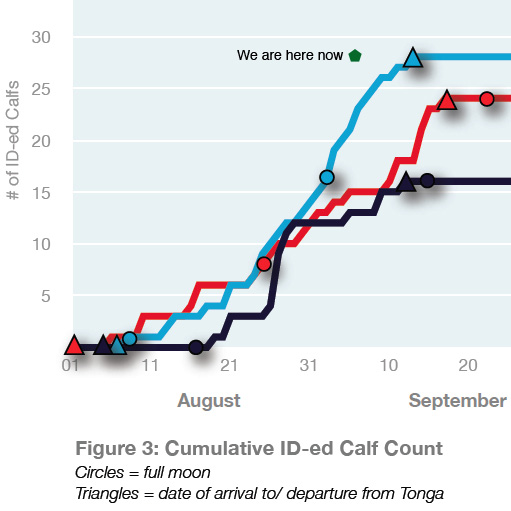
Still on track for a record number of humpback whale babies
(black = 2008; blue = 2009; red = 2010).
Extracted from my 2010 humpback calf summary.
Besides confirming several new calf IDs, we’ve also had some repeat-sightings this week:
- 31 August: Hiva, calf #9, originally ID-ed on 19 August (13-day interval)
- 01, 02, and 03 September: Tahafa, calf #14 (the injured calf), originally ID-ed on 23 August (10- to 12-day interval)
Less-than-ideal visibility (even far offshore) has continued to make taking underwater photos difficult, and the “neutral” whale behaviour I alluded to in previous updates has for the most part continued.
We still haven’t had any Ikumi-esque encounters...meaning extended quality time with a chilled-out mom and an engaged baby. I know that there have been some good encounters, but they’ve been few and far between, especially considering the number of whales around.
One possible contributor to this may be the number of mom/ calf pairs that have been accompanied by escorts, especially in recent days. In most cases, the escorts seem to have been “pushing” the female whales and their babies along, reflected in the whales’ non-stop swimming and erratic twists and turns. (Refer to the Two Timer discussion in Part 3).
It’s important to note that this type of behaviour is taking place with or without boats nearby. We’ve watched mom/ calf/ escorts from afar...looking on as the whales zigged, zagged, sped up, slowed down...basically did everything but stop and sit still.
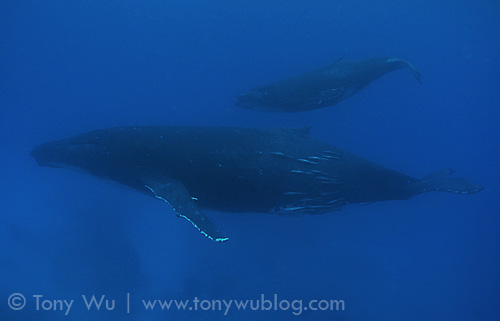
Uaono (calf #26) with mom. Low viz, cloudy skies
and nonstop whales makes ID-ing difficult
With Uaono (calf #26) for instance, we watched as the mom/ calf/ escort trio pinballed haphazardly around the area between Tungasika and White Patch. At one point, we saw mom and baby head one way, and escort head another. Right after I pointed and remarked: “Hey, what’s going on?”, the escort breached several times, while cow and calf swam away.
One of the things Ongo, my whale mentor in Vava’u, used to say to me was: “When a female rejects an escort, the males often breach in frustration.” I was sceptical when he first shared this observation with me many years ago, but I’ve seen this scenario play out often enough now that I’m certain he was correct.
Unfortunately though, Uaono and mom didn’t appear to take comfort in the escort’s disappearance. They slowed down for a bit, then took off at top speed toward White Patch and straight out to sea, making it impossible to get a good look in the water.
Talking Toku
Recent arrivals Dan, Kozy, Sean, Nana and Ray had their first day on the water on Friday.
It was cloudy, but the winds were down, so we decided to head to Toku, a small island located about 40km from Vava’u. I had only been there once before (last year) and had a kick-@** time, so I decided it was worth taking the group there, even if they still hadn’t had the opportunity to learn the ropes.
The calculated risk paid off.
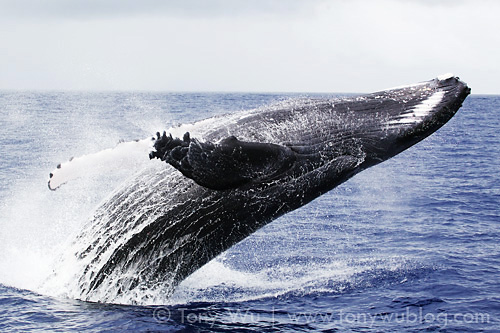
Breaching humpback whale that put on quite a show
Before reaching the island, we saw blows all over the place. We started to follow a pair of whales, hoping for an in-water encounter right away. As luck would have it, we weren’t able to see them underwater, but that was because the larger of the two whales put on a spectacular, non-stop breaching show for us.
I’m not sure how long the breach-bonanza lasted, but we followed for quite a while, perhaps an hour or more. The pertinent whale repeatedly took two to three breaths, dived, and fifteen seconds or so later...breach!!! Everyone took photos. Nana even posted iPhone snaps. How many people can boast of taking close-up humpback whale breaching photos on an iPhone?
After that, we spent the rest of the day with two mother/ calf/ escort trios, both in pretty much the same area. Though both groups of whales moved non-stop (despite my desperate pleas of: “Cut me some slack guys!”), we managed a number of drops with Uatolu (calf #23, a little baby girl) in shallow water.
If conditions permit, we’ll definitely head for Toku again in the coming days.
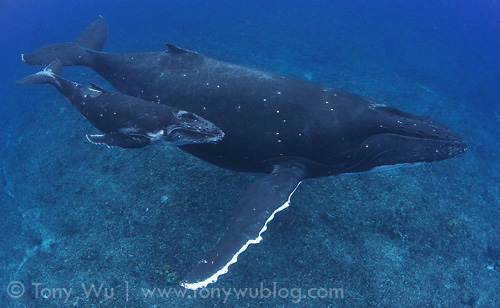
Little baby Uatolu (calf #23, female) going for a stroll with her mom
Update: Injured Calf
Below is a close-up photo of the Tahafa (calf #14), the injured baby that I discussed in last week’s update.
Shawn and John observed this baby on 01 September (10 days after we first ID-ed the baby), and noted that the juvenile seemed lethargic and lacked energy/ spunk. This, of course, had us worried.
Over the next two days, however, Emiko and Takaji had two additional encounters, during which time the baby breached and played a lot, appearing for all practical purposes to be as healthy as any other little whale...much to our collective relief.
The precise cause of the baby’s injuries is still a topic of discussion/ debate here. I continue to believe that the balance of probability lies with an attack by a group of marine mammals, but another theory put forth by credible/ experienced people here suggests a boat collision as a possible cause.
While we may never know the actual cause with complete certainty, we certainly all hope that this baby thrives and returns in the future. We’ll most likely be able to recognise this whale by the missing anterior portion of its dorsal fin.
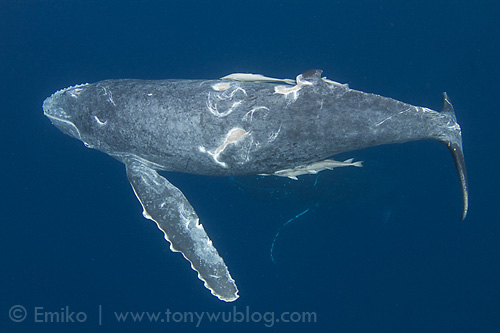
Top-down view of Tahafa's (calf #14) injuries
White Pecs
Well...we’re up to eight whales with all-white or nearly all-white pectoral fins now.
That’s fascinating enough, given the relative paucity of white-handed whales here in most seasons, but even more exciting...the latest white pec is a calf I ID-ed yesterday, Uafitu (calf #27). This is the first time I’ve ever seen a calf here with all-white pectoral fins.
We came across this calf entirely by accident, while we were waiting for a singer. This special baby, along with mom and escort, literally “popped up” of the blue, taking us by surprise.
From above, we could see that the baby had all-white pectoral fins, so it was particularly nerve-wracking when the whales eluded us for several minutes, despite flat-calm conditions.
True to the escort-induced-ping-pong-pattern of motion that’s been all-too-common of late, this trio was difficult. There was no predictable method to their madness, so following them was more gut instinct than measured approach. It took a few tries, but in the end, I was able to get up-close ID-shots of the baby.
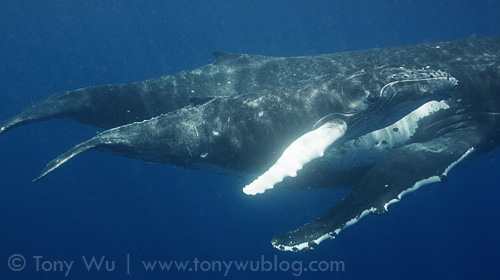
Uafitu (calf #27), the first humpback whale baby I've seen with all-white pectoral fins
I’ve been keeping an eye out for whales with all-white pectoral fins here since I noticed a similar surge in their numbers back in 2006. This fluke morph is relatively more common in the northern hemisphere, so it was natural to wonder whether there could possibly be crossover from north to south.
Back in ’06, some researcher friends were kind enough to forward me a couple of research papers that suggested such a phenomenon might be possible. But even so, it shouldn’t be a common occurrence if it takes place at all, given the disparity in seasons and locations of the two populations at any given time in the year.
Sighting this baby now provides me with proof-positive that white-handed babies are born in the south. Probably not too exciting for most people...but a major thrill for me!
Headcount: +11, -2
As you may have gathered, this past week was a period of transition for my groups of visitors.
Besides sending off eight people during the week, I was scheduled to have five people arrive from Japan and six people from other countries...Taiwan, Thailand, the US, Canada and Russia.
But on Tuesday, I lost the Russian. Followed by one of the Japanese. Instead of 11 people, I ended up with only nine.
We all miss you Andrey, Yokomoto-san!
Both people had their travel plans interrupted due to minor bureaucratic snafus. In Andrey’s instance, transiting through Australia required a visa, even though he wasn’t ever setting foot in the country. Silly, but this requirement is more common than you might imagine.
In Yokomoto-san’s case, Tonga (like many other countries) requires tourists to have at least six months of validity remaining for their passports. He had four or five.
In both cases, the relevant bureaucracies were unable/ unwilling to help, which sadly meant cancelled trips.
To try to learn from this unfortunate turn of events...if you are planning an upcoming trip to any destination, please make sure that you don’t need visas for transit, and also that you have at least six months left (from your planned date of entry to the country concerned) before your passport expires.

Intrepid travellers who left this week:
Geri, Minako (oops! only hat visible), Serene, Trevor, May and Maria